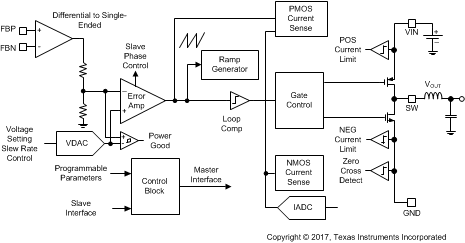SNVSAW2B April 2017 – December 2018 LP87524B-Q1 , LP87524J-Q1 , LP87524P-Q1
PRODUCTION DATA.
- 1 Features
- 2 Applications
- 3 Description
- 4 Revision History
- 5 Pin Configuration and Functions
- 6 Specifications
-
7 Detailed Description
- 7.1 Overview
- 7.2 Functional Block Diagram
- 7.3
Feature Descriptions
- 7.3.1 DC-DC Converters
- 7.3.2 Sync Clock Functionality
- 7.3.3 Power-Up
- 7.3.4 Regulator Control
- 7.3.5 Enable and Disable Sequences
- 7.3.6 Device Reset Scenarios
- 7.3.7 Diagnostics and Protection Features
- 7.3.8 GPIO Signal Operation
- 7.3.9 Digital Signal Filtering
- 7.4 Device Functional Modes
- 7.5 Programming
- 7.6
Register Maps
- 7.6.1
Register Descriptions
- 7.6.1.1 OTP_REV
- 7.6.1.2 BUCK0_CTRL1
- 7.6.1.3 BUCK1_CTRL1
- 7.6.1.4 BUCK2_CTRL1
- 7.6.1.5 BUCK3_CTRL1
- 7.6.1.6 BUCK0_VOUT
- 7.6.1.7 BUCK0_FLOOR_VOUT
- 7.6.1.8 BUCK1_VOUT
- 7.6.1.9 BUCK1_FLOOR_VOUT
- 7.6.1.10 BUCK2_VOUT
- 7.6.1.11 BUCK2_FLOOR_VOUT
- 7.6.1.12 BUCK3_VOUT
- 7.6.1.13 BUCK3_FLOOR_VOUT
- 7.6.1.14 BUCK0_DELAY
- 7.6.1.15 BUCK1_DELAY
- 7.6.1.16 BUCK2_DELAY
- 7.6.1.17 BUCK3_DELAY
- 7.6.1.18 GPIO2_DELAY
- 7.6.1.19 GPIO3_DELAY
- 7.6.1.20 RESET
- 7.6.1.21 CONFIG
- 7.6.1.22 INT_TOP1
- 7.6.1.23 INT_TOP2
- 7.6.1.24 INT_BUCK_0_1
- 7.6.1.25 INT_BUCK_2_3
- 7.6.1.26 TOP_STAT
- 7.6.1.27 BUCK_0_1_STAT
- 7.6.1.28 BUCK_2_3_STAT
- 7.6.1.29 TOP_MASK1
- 7.6.1.30 TOP_MASK2
- 7.6.1.31 BUCK_0_1_MASK
- 7.6.1.32 BUCK_2_3_MASK
- 7.6.1.33 SEL_I_LOAD
- 7.6.1.34 I_LOAD_2
- 7.6.1.35 I_LOAD_1
- 7.6.1.36 PGOOD_CTRL1
- 7.6.1.37 PGOOD_CTRL2
- 7.6.1.38 PGOOD_FLT
- 7.6.1.39 PLL_CTRL
- 7.6.1.40 PIN_FUNCTION
- 7.6.1.41 GPIO_CONFIG
- 7.6.1.42 GPIO_IN
- 7.6.1.43 GPIO_OUT
- 7.6.1
Register Descriptions
- 8 Application and Implementation
- 9 Power Supply Recommendations
- 10Layout
- 11Device and Documentation Support
- 12Mechanical, Packaging, and Orderable Information
- 12Mechanical, Packaging, and Orderable Information
Package Options
Refer to the PDF data sheet for device specific package drawings
Mechanical Data (Package|Pins)
- RNF|26
Thermal pad, mechanical data (Package|Pins)
Orderable Information
7.3.1.1 Overview
The LP87524B/J/P-Q1 includes four step-down DC-DC converter cores configured for four single-phase outputs. The cores are designed for flexibility; most of the functions are programmable, thus giving a possibility to optimize the regulator operation for each application.
The LP87524B/J/P-Q1 has the following features:
- DVS support
- Automatic mode control based on the loading (PFM or PWM mode)
- Forced-PWM mode operation
- Optional external clock input to minimize crosstalk
- Optional spread spectrum technique to reduce EMI
- Phase control for optimized EMI
- Synchronous rectification
- Current mode loop with PI compensator
- Soft start
- Power Good flag with maskable interrupt
- Power Good signal (PGOOD) with selectable sources
- Average output current sensing (for PFM entry and load current measurement)
The following parameters can be programmed via registers:
- Output voltage
- Forced-PWM operation
- Enable and disable delays for regulators and GPIOs controlled by ENx pins
There are two modes of operation for the converter, depending on the output current required: pulse-width modulation (PWM) and pulse-frequency modulation (PFM). The converter operates in PWM mode at high load currents of approximately 600 mA or higher. Lighter output current loads cause the converter to automatically switch into PFM mode for reduced current consumption when forced-PWM mode is disabled.
A multi-phase synchronous buck converter offers several advantages over a single power stage converter. For application processor power delivery, lower ripple on the input and output currents and faster transient response to load steps are the most significant advantages. Also, because the load current is evenly shared among multiple channels in multi-phase output configuration, the heat generated is greatly reduced for each channel due to the fact that power loss is proportional to square of current. The physical size of the output inductor shrinks significantly due to this heat reduction. A block diagram of a single core is shown in Figure 5.
 Figure 5. Detailed Block Diagram Showing One Core
Figure 5. Detailed Block Diagram Showing One Core